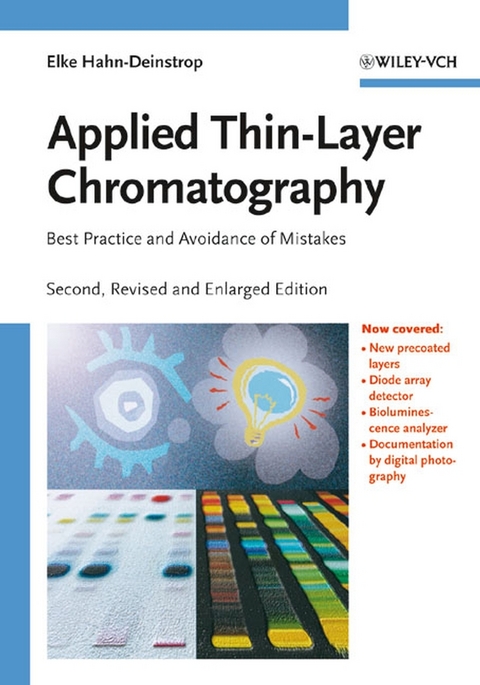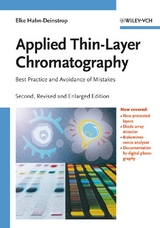Applied Thin-Layer Chromatography
Wiley-VCH (Verlag)
978-3-527-31553-6 (ISBN)
- Titel gebraucht verfügbar
- Artikel merken
Das Praxisbuch zur DC jetzt auch in englischer Sprache!Die Dünnschicht-Chromatographie ist eine schnelle und preiswerte Analysemethode mit Anwendungen, die sich u. a. in der Arzneimittel-, Lebensmittel- und Umweltanalytik bewährt hat. Das Buch ist ein Leitfaden für die praktische Arbeit und eine wertvolle Hilfe bei der Fehlersuche und -vermeidung. Das Praxisbuch zur DC jetzt auch in englischer Sprache!Aus einer Besprechung der deutschen Ausgabe:'Die Summe von praktischen Tips macht das Buch zu einem Nachschlagewerk, das in jedes Labor gehört, wo dünnschichtchromatographisch gearbeitet wird. ... Durch die konsequente Erläuterung aller, auch für den Praktiker geläufigen, Vorgehensweisen und Begriffe und seiner sehr einfachen Sprache eignet sich das Buch sehr gut als Lehrbuch und wird sicherlich bei der Ausbildung von Laboranten in der Pharmazeutischen und Chemischen Industrie sowie von Apothekern und PTA's eine weite Verbreitung finden.'(Deutsche Apotheker Zeitung)
After working for many years for Heumann Pharma (now part of Pfizer), where she was in particular responsible for the training and education of lab technicians, Elke Hahn-Deinstrop is now a freelance consultant for thin-layer chromatography. She is author of numerous papers and frequent lecturer.
INTRODUCTION
What is TLC?
When is TLC used?
Where is TLC used
How is the result of a TLC represented?
What kinds of reference substances are used in TLC?
The literature on TLC
PRECOATED LAYERS
Why use precoated layers?
How are precoated layers produced?
What kinds of precoated layers are there?
What are precoated layers used for?
Criteria for choosing stationary phases in TLC
Effect of the stationary phase when the solvents are identical
Recommendations for the procurement and storage of precoated layers
Problems in the nomenclature and classification of precoated layers
BEFORE TLC DEVELOPMENT
Handling of the precoated layers
Prewashing
Activation
Conditioning
Impregnation
Application of the sample
Positioning of the sample
Drying before development
SOLVENT, DEVELOPING CHAMBERS AND DEVELOPMENT
Solvent
TLC developing chambers
Development of thin-layer chromatograms
Drying after development
EVALUATION WITHOUT DERIVATIZATION
Visual direct evaluation
Optical direct evaluation using special equipment
Coupling methods for substance identification
Documentation without or before derivatization
DERIVATIZATION
Thermochemical reaction
Irradiation with high energy light
Reaction with reagents
Special types of derivatization
Treatment of derivatized chromatograms
EVALUATION AFTER DERIVATIZATION
Visual evaluation
Evaluation by TLC scanner
Evaluation by video system
Evaluation by flat-bed scanner
DOCUMENTATION
Description of a thin-layer chromatogram
Documentation by reproduction, tracing or photocopying
Photographic documentation
Video documentation
TLC scanner documentation
Flat-bed scanner documentation
GMP/GLP-CONFORMING TLC WORK
Validation of TLC methods
Use of qualified
calibrated equipment
GMP/GLP-conforming rawdata sheets
Examples of GMP/GLP-conforming testing procedures
LOADING EFFECTS
Definite loading of a substance
TLC of sensitive substances
SPECIAL METHODS IN TLC
AMD - Automated Multiple Development
OPLC - Overpressured Layer Chromatography
HPPLC - High Pressure Planar Liquid Chromatography
TLC-FID/FTID - Combination of TLC with Flame Ionization Detector or Flame Thermoionic Ionization Detector
RPC - Rotation Planar Chromatography
Appendix
Chromatography and art
References
Abbreviations used
Acknowledgements
Market review
"...an excellent practical guide to the utilization of this useful analytical procedure." ( Journal of Hazardous Materials , June 25, 2007)
"This impressive book thoroughly discusses a subject not usually covered thoroughly in the analytical chemistry literature." ( CHOICE , June 2007)
| Erscheint lt. Verlag | 20.10.2006 |
|---|---|
| Sprache | englisch |
| Maße | 170 x 240 mm |
| Gewicht | 795 g |
| Themenwelt | Naturwissenschaften ► Chemie ► Analytische Chemie |
| Schlagworte | Analytical Chemistry • Analytische Chemie • Chemie • Chemie / Allgemeines, Lexika • Chemistry • Chromatographie / Trennverfahren • Chromatography / Separation Techniques • Dünnschichtchromatographie • Environmental Analysis • Industrial Chemistry • Technische u. Industrielle Chemie • Umweltanalytik |
| ISBN-10 | 3-527-31553-5 / 3527315535 |
| ISBN-13 | 978-3-527-31553-6 / 9783527315536 |
| Zustand | Neuware |
| Haben Sie eine Frage zum Produkt? |
aus dem Bereich





